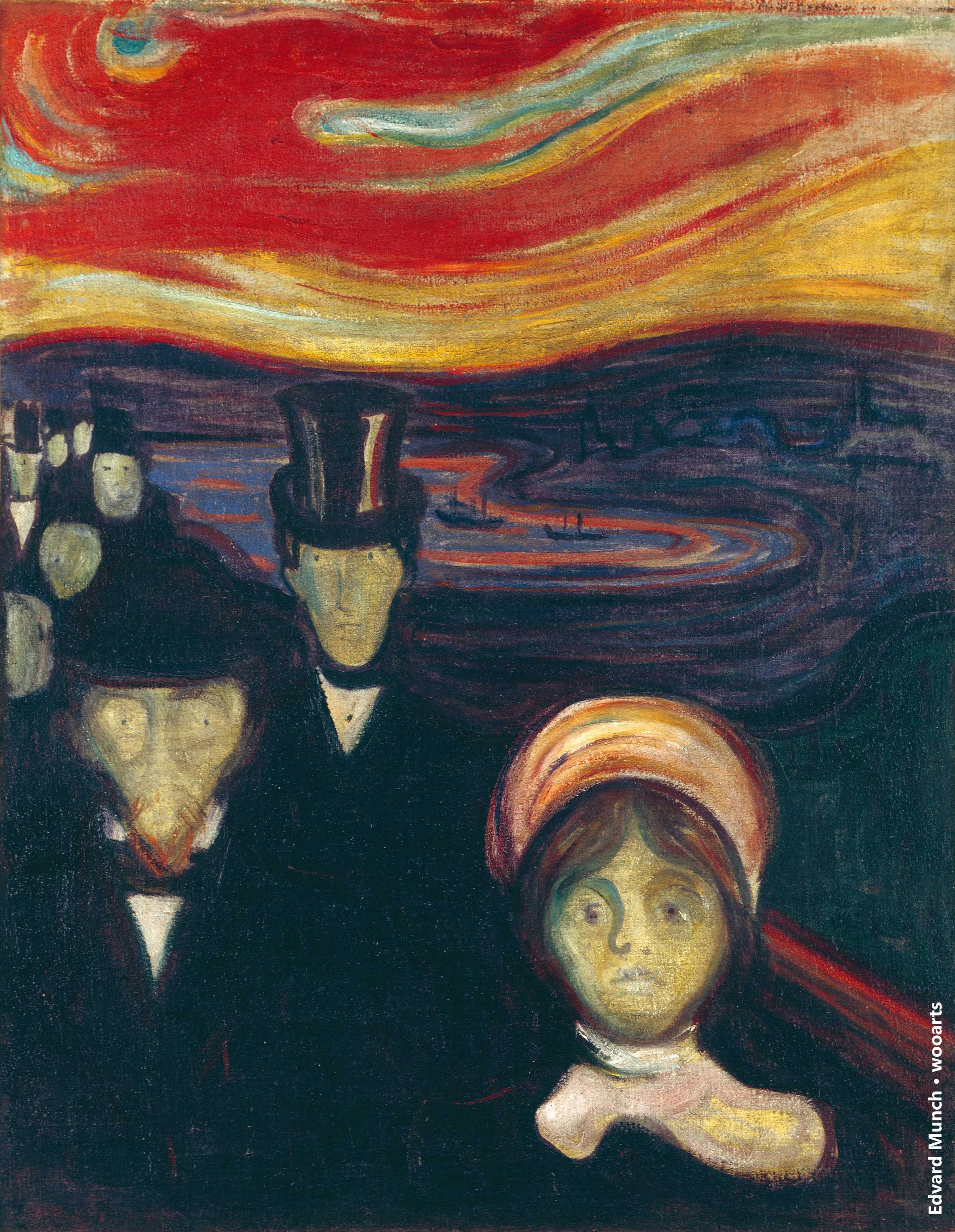Edvard Munch, the iconic Norwegian painter and printmaker, is best known for his profound impact on modernist art, most famously encapsulated in his haunting piece “The Scream.” His obsession with the human condition and emotional landscapes unfolds powerfully in works like “Two Human Beings (The Lonely Ones),” which is currently featured in an enlightening exhibition at the Harvard Art Museums. Over a prolific career spanning 40 years, Munch revisited this theme, exploring the complexities of companionship and isolation through various artistic interpretations. This exploration not only highlights the evolution of his technique but also invites viewers to reflect on the depth of human relationships. As we delve into Munch’s extraordinary body of work, we uncover how his paintings serve as both a mirror and a canvas for our own emotional experiences.
Exploring the legacy of Edvard Munch reveals a treasure trove of insights related to the themes of loneliness and companionship that permeate his art. Often associated with the realm of modern expressionism, Munch’s pieces like “Two Human Beings” showcase an intricate dance between male and female figures, illustrating the nuanced dynamics of their relationship against a melancholic backdrop. His innovative approach to printmaking and oil painting not only demonstrates technical mastery but also enhances the emotional potency of his motifs. The ongoing exhibition at the Harvard Art Museums serves as a crucial platform for examining Munch’s perpetual engagement with these subjects, inviting art enthusiasts and casual observers alike to reconnect with the timeless struggles of human connection that he so poignantly captures.
Exploring Edvard Munch’s Iconic Motif of Two Human Beings
Edvard Munch’s “Two Human Beings” has become one of the landmark motifs within modernist art, captivating audiences with its profound emotional depth. This painting captures a man and a woman standing side by side by the shore, yet their posture reflects a sense of isolation. The figures are often depicted as gazing into the distance, suggesting contemplation and a nuanced struggle between intimacy and loneliness. Munch’s repeated exploration of this theme over four decades reveals the artist’s preoccupation with human relationships, pushing boundaries in both painting and printmaking to communicate his thoughts on companionship and solitude.
The significance of this motif goes beyond mere representation. Munch’s variations in color, technique, and form allow viewers to engage with the work dynamically, prompting various interpretations. Initially perceived as a depiction of loneliness, Roth reveals that the intent may also convey connection, as both figures are visually united by shared hues and soft brushstrokes. This juxtaposition encourages discussions about empathy and the complexities inherent in human relationships, reinforcing Munch’s status as a pioneer of modernist art who beautifully intertwined emotion with aesthetic exploration.
The Intersection of Painting and Printmaking in Munch’s Work
Munch’s journey with “Two Human Beings” highlights the interconnectivity of his painting and printmaking practices. Initially, Munch painted this iconic motif in 1892, yet an unfortunate incident led to its destruction. This setback did not deter Munch; instead, it intensified his creative exploration, leading him to produce several print iterations. Munch’s method often included deconstructing and reconstructing the motif, where he would cut individual elements from woodblocks to explore endless color variations. This innovative jigsaw approach not only pushed the boundaries of traditional printmaking but also enriched his painting techniques, revealing a complex dialogue between the two media.
Munch’s decision to leave pieces of canvas unpainted or to expose his preparatory sketches in his paintings suggests a deliberate embrace of imperfection. Rather than seeking a polished finish, he chose to allow the rawness of his process to shine through. This approach contributed to the dynamism within his works: the layering of colors, textural contrasts, and the tactile quality inherent in his prints and paintings resonate with the viewer on multiple levels. Through this interplay, Munch challenges the conventions of modern art, urging artists and audiences alike to appreciate the beauty found in the vulnerabilities of artistic expression.
Munch’s Repeated Themes: Loneliness vs. Connection
The many iterations of “Two Human Beings” prompt a critical examination of the themes of loneliness and connection. Over time, interpretations of this artwork have often leaned towards the idea that the figures represent a profound sense of isolation, even when together. However, as explored in the exhibition, Munch’s intent may delve deeper, symbolizing a nuanced companionship that exists alongside existential contemplation. Roth emphasizes this idea by suggesting the figures’ shared colors create a visual bond that could indicate a deeper connection, challenging the viewer’s initial perceptions of sheer loneliness.
This duality reflects Munch’s understanding of the human condition. While he acknowledges the often painful reality of isolation, he also presents the possibility that connections exist through shared experiences and emotional landscapes. Rather than being merely solitary figures, the man and woman embody a complex relationship, inviting viewers to reflect on their own connections in life. Munch’s ability to convey these intricate emotional states elevates his work within the canon of modernist art, highlighting his role not just as a chronicler of despair but as an observer of the multifaceted nature of human relationships.
The Artistic Techniques Behind Munch’s Greatness
In exploring Munch’s artistic techniques, the interplay of color, form, and texture takes center stage. Known for employing a wide range of painting techniques, Munch often left some areas of his canvases intentionally bare, allowing the spontaneous essence of his creative process to breathe. This method adds a vibrancy and energy to paintings like “Two Human Beings.” By using thick paint in some areas while scratching color away in others, Munch establishes a unique dynamism that enhances the viewer’s emotional response. The visible brushstrokes and spontaneous application dance across the canvas, creating a visceral connection to the figures.
Munch’s innovative use of prints as a medium allows for a further exploration of his themes. The process of cutting and reassembling prints not only speaks to his technical prowess but also allows for a greater examination of perspective and color variation. Each print becomes a new opportunity to convey emotion differently, offering endless possibilities of interpretation. This technique underscores Munch’s belief that imperfections and variations in alignment enhance the character of a piece, revealing the artist’s enduring commitment to authenticity in his work.
Munch’s Legacy in Modernist Art
Edvard Munch’s contributions to modernist art extend far beyond individual works like “The Scream” and “Two Human Beings.” His ability to intertwine personal experience with universal themes of love, loss, and existential inquiry has left an indelible mark on the art world. Munch’s distinct style, characterized by emotional depth and vivid expression, resonates within modernist movements, influencing countless artists who followed. By effectively capturing the complexities of human emotion through varied media, Munch not only shaped the trajectory of modern art but also provided a framework for emotional expression that is still relevant today.
Moreover, Munch’s willingness to explore psychological themes through his art prompted a broader conversation within the art community. As noted in the ongoing exhibition at Harvard, Munch’s work encourages viewers to disentangle the artist’s struggles from his creative output. This exploration enhances the understanding that the art itself serves as both a reflection of personal turmoil and an innovative exploration of humanity’s emotional landscape. In doing so, Munch ensures his lasting relevance while establishing a significant legacy within both contemporary and historical contexts in the realm of modernist art.
Understanding the Personal and Professional Dichotomy of Munch
While Edvard Munch is often regarded as a deeply troubled artist, the exhibition “Edvard Munch: Technically Speaking” sheds light on the intricate balance between his personal experiences and professional identity. Munch faced personal crises that influenced his artistic output, yet he was also astute in cultivating his public persona. He meticulously crafted his legacy during his lifetime, promoting his work while simultaneously exploring the depths of human emotion through his art. This duality challenges the perception of Munch solely as a tortured genius, showcasing him instead as a dynamic figure who understood the importance of both vulnerability and engagement within his practice.
This understanding of the intersection between Munch’s psychological struggles and his mastery of artistic techniques offers a richer dialogue about his work. By articulating the complexities of isolation and connection in pieces like “Two Human Beings,” Munch invites viewers to consider not just the aesthetic experiences but also the emotional narratives at play. This complexity ensures Munch’s works remain relevant across generations, serving as valuable explorations of the human condition that extend the boundaries of modernist art.
The Role of Harvard Art Museums in Preserving Munch’s Work
The Harvard Art Museums play a pivotal role in the preservation and exhibition of Edvard Munch’s artistic legacy. Housing one of the largest collections of Munch’s works outside Norway, the museums provide invaluable insight into his methodologies and thematic explorations. Through exhibitions such as “Edvard Munch: Technically Speaking,” audiences are given the opportunity to engage with Munch’s oeuvre in a comprehensive context, gaining a deeper appreciation for his artistic innovations and emotional depth. This accessibility fosters an ongoing dialogue about Munch’s influence on modern art.
Moreover, the transformative donations that have enhanced the museums’ collection underscore the importance of continued scholarship and support for the arts. By showcasing Munch’s diverse techniques—from painting to printmaking—the Harvard Art Museums reinforce the vital connections between historical context and contemporary artistic practice. This commitment ensures that Munch’s legacy endures, inviting new audiences to explore the emotional landscapes intricately woven throughout his body of work.
Munch’s Influence on Future Generations of Artists
Edvard Munch’s innovative spirit has left a lasting legacy that continues to resonate with future generations of artists. His ability to evoke deep emotional responses through varied mediums, particularly in capturing themes of isolation, anxiety, and human connection, has inspired many contemporary creators. Artists today often draw upon Munch’s fearless exploration of psychological subjects, reflecting a similar intensity in their own works. His influence is evident across disciplines, from painting to sculpture and even performance art, highlighting the enduring relevance of his techniques and themes.
Furthermore, the ways in which Munch challenged traditional artistic boundaries inspire current artists to experiment with their creative processes. His willingness to embrace imperfection and process-oriented practices encourages a new generation to view art not merely as a final product but as an exploration of the human experience. This philosophy resonates deeply in today’s art world, where authenticity and emotional resonance remain at the forefront of artistic innovation, truly making Edvard Munch a foundational figure in the narrative of modernist and contemporary art.
Frequently Asked Questions
What inspired Edvard Munch’s ‘Two Human Beings’ paintings?
Edvard Munch’s ‘Two Human Beings’ series draws from a decades-long exploration of the themes of companionship and isolation. Through this motif, he illustrates the tension between connection and loneliness, showcasing two figures—man and woman—by the shore, often rendered in various techniques that emphasize their emotional state.
How many times did Edvard Munch revisit the theme of ‘Two Human Beings’?
Edvard Munch revisited the theme of ‘Two Human Beings’ multiple times over a span of 40 years, producing numerous iterations including paintings, etchings, and woodcut prints. Each version presents subtle variations, allowing Munch to explore different emotional and aesthetic dimensions of the subject.
What techniques did Edvard Munch use in ‘Two Human Beings’?
In ‘Two Human Beings,’ Edvard Munch employed a variety of painting techniques, including thick applications of paint, unpainted canvas areas, and scratching away color. These methods contribute to the dynamism and tension within the artwork, enhancing the emotional landscape he aims to convey.
Where can I view Edvard Munch’s ‘Two Human Beings’ at the Harvard Art Museums?
You can view Edvard Munch’s ‘Two Human Beings’ at the Harvard Art Museums as part of the exhibition ‘Edvard Munch: Technically Speaking,’ which showcases various installments of this theme, allowing visitors to engage with Munch’s artistic evolution.
What is the significance of the motifs in Edvard Munch’s art?
The motifs in Edvard Munch’s art, such as ‘Two Human Beings,’ serve as critical explorations of human emotion and psychological states. They reflect Munch’s blend of personal experience with broader existential themes, emphasizing feelings of isolation and companionship.
What was Edvard Munch’s approach to imperfections in his artwork?
Edvard Munch embraced imperfections within his artwork, often leaving visible sketch lines and areas of unpainted canvas. He believed that these elements contributed to the raw emotion and authenticity of his pieces, countering the notion that perfection is necessary in art.
Why is ‘Two Human Beings’ considered iconic in Edvard Munch’s body of work?
‘Two Human Beings’ is considered iconic in Edvard Munch’s body of work due to its recurring exploration of complex emotional themes such as loneliness and connection, as well as its stylistic innovation that foreshadows modernist art. This motif captures the essence of human experience in a visually poignant manner.
| Aspect | Details |
|---|---|
| Exhibition | ‘Edvard Munch: Technically Speaking’ at Harvard Art Museums, until July 27. |
| Artwork | ‘Two Human Beings (The Lonely Ones)’, painted between 1906 and 1908, reflecting themes of companionship and isolation. |
| Technique | Munch used various techniques such as thick paint application, visible sketches, and unpainted canvas to create a sense of dynamism. |
| Motif | Munch’s repeated motif of two figures at the shore reflects changing perspectives and emotional depth over 40 years. |
| Interpretation | Originally seen as a reflection of loneliness, the motif also explores companionship, connectedness, and contemplation. |
| Legacy | Munch is recognized as a pivotal figure in Modernism, connecting emotions with artistic innovation across multiple mediums. |
Summary
Edvard Munch, a renowned Norwegian artist, is celebrated for his profound exploration of human emotions through art. His piece, “Two Human Beings (The Lonely Ones),” encapsulates his fascination with the dualities of companionship and isolation. Through his innovative techniques and repeated motifs, Munch invites viewers to experience a dynamic interplay of emotions. The ongoing exhibition at Harvard Art Museums highlights the unique evolution of his work, reinforcing his significance in the Modernist movement and encouraging a deeper understanding of his artistic legacy.



